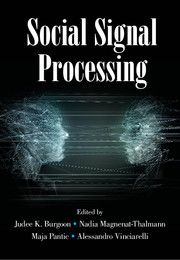Book contents
- Frontmatter
- Contents
- Contributors
- 1 Introduction: Social Signal Processing
- Part I Conceptual Models of Social Signals
- Part II Machine Analysis of Social Signals
- Part III Machine Synthesis of Social Signals
- Part IV Applications of Social Signal Processing
- 24 Social Signal Processing for Surveillance
- 25 Analysis of Small Groups
- 26 Multimedia Implicit Tagging
- 27 Social Signal Processing for Conflict Analysis and Measurement
- 28 Social Signal Processing and Socially Assistive Robotics in Developmental Disorders
- References
28 - Social Signal Processing and Socially Assistive Robotics in Developmental Disorders
from Part IV - Applications of Social Signal Processing
Published online by Cambridge University Press: 13 July 2017
- Frontmatter
- Contents
- Contributors
- 1 Introduction: Social Signal Processing
- Part I Conceptual Models of Social Signals
- Part II Machine Analysis of Social Signals
- Part III Machine Synthesis of Social Signals
- Part IV Applications of Social Signal Processing
- 24 Social Signal Processing for Surveillance
- 25 Analysis of Small Groups
- 26 Multimedia Implicit Tagging
- 27 Social Signal Processing for Conflict Analysis and Measurement
- 28 Social Signal Processing and Socially Assistive Robotics in Developmental Disorders
- References
Summary
Introduction
Multimodal social-emotional interactions play a critical role in child development and this role is emphasized in autism spectrum disorders (ASD). In typically developing children, the ability to correctly identify, interpret, and produce social behaviors (Figure 28.1) is a key aspect for communication and is the basis of social cognition (Carpendale & Lewis, 2004). This process helps children to understand that other people have intentions, thoughts, and emotions and act as a trigger of empathy (Decety & Jackson, 2004; Narzisi et al., 2012). Social cognition includes the child's ability to spontaneously and correctly interpret verbal and nonverbal social and emotional cues (e.g., speech, facial and vocal expressions, posture and body movements, etc.); the ability to produce social and emotional information (e.g., initiating social contact or conversation); the ability to continuously adjust and synchronize behavior to others (i.e., parent, caregivers, peers); and the ability to make an adequate attribution about another's mental state (i.e., “theory of mind”).
Definitions and Treatments
ASDs are a group of behaviorally defined disorders with abnormalities or impaired development in two areas: (1) persistent deficits in social communication and social interaction and (2) restricted, repetitive patterns of behavior, interests, or activities. An individual with ASD has difficulty interacting with other people due to an inability to understand social cues as well as others’ behaviors and feelings. For example, children with ASD often have difficulty with cooperative play with other peers; they prefer to continue with their own repetitive activities (Baron-Cohen & Wheelwright, 1999). Persons with ASD evaluate both world and human behavior uniquely because they react in an abnormal way to input stimuli while there is problematic human engagement and inability to generalize the environment (Rajendran & Mitchell, 2000). Although ASD remains a devastating disorder with a poor outcome in adult life, there have been important improvements in treating ASD with the development of various therapeutic approaches (Cohen, 2012).
Successful autism “treatments” using educational interventions have been reported as recently as a decade ago (Murray, 1997). Since then, the literature devoted to the description and evaluation of interventions in ASD has become substantial over the last few years. From this literature, a number of conclusions can be drawn. First, there is increasing convergence between behavioral and developmental methods (Ospina et al., 2008).
- Type
- Chapter
- Information
- Social Signal Processing , pp. 389 - 403Publisher: Cambridge University PressPrint publication year: 2017
References
- 4
- Cited by



